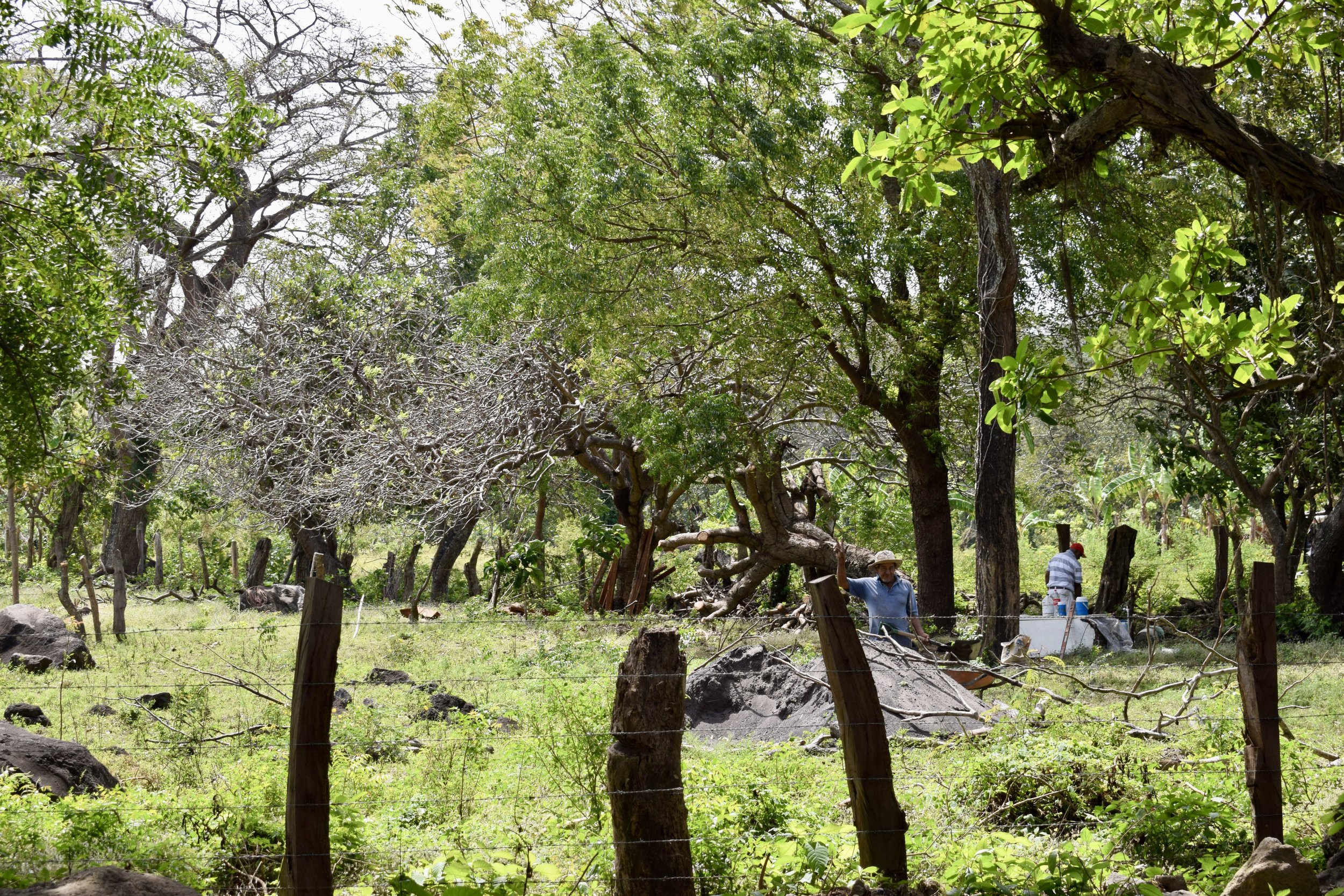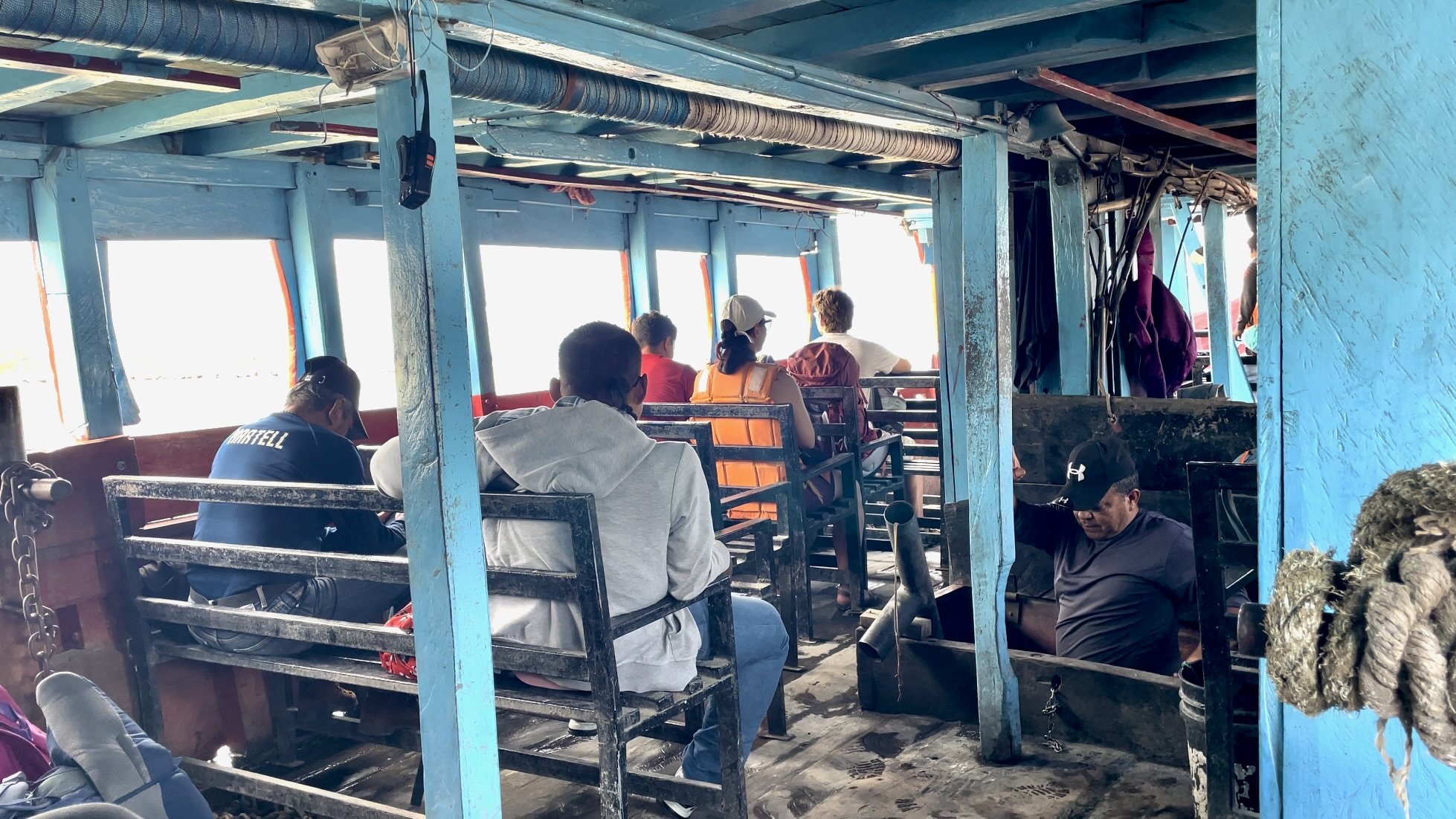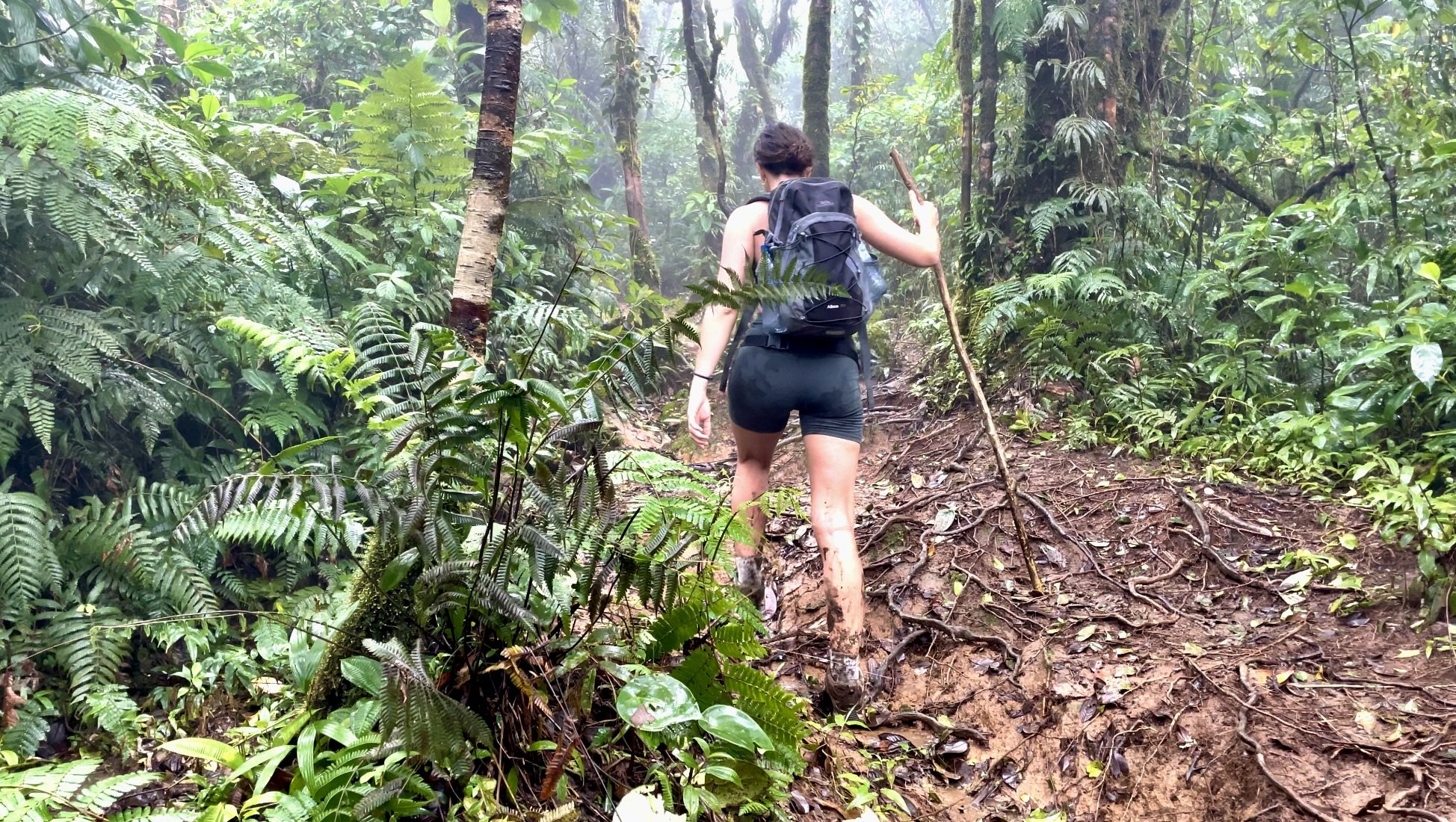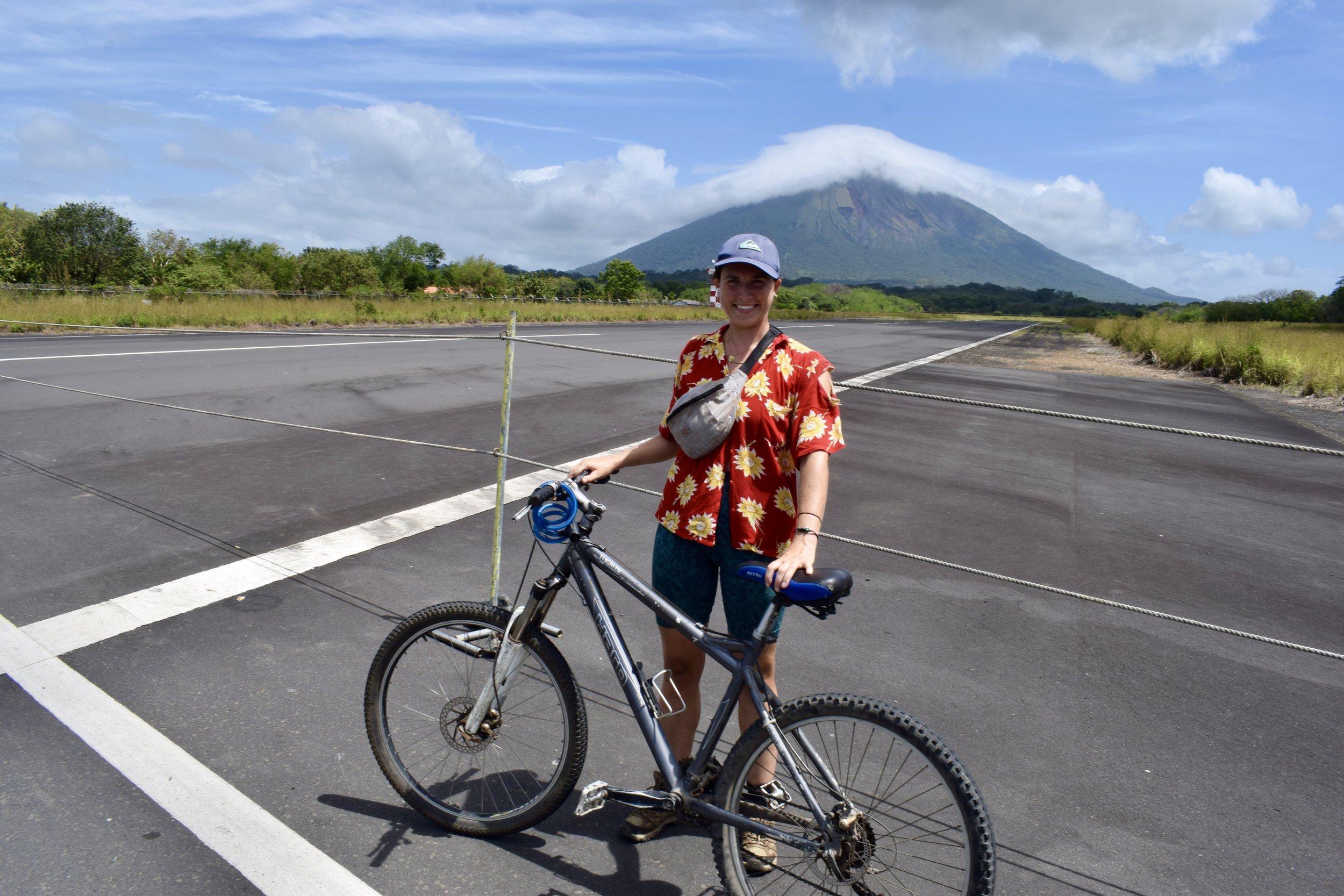Cycling (and hiking) around Ometepe: Essential Information
Cycling around Ometepe, you can expect to feel a deep sense of joy and freedom. As you pedal your way around the island’s two towering volcanoes, you’ll pass tranquil lakeside vistas, weave through lush banana plantations, and venture into some of the island’s most remote and peaceful corners.
Along the way, you’ll have the chance to stop and chat with friendly locals, gaining a glimpse into daily life on the island. At other times, you’ll ride for miles without seeing another soul – just you, the open road, and the untamed beauty of Ometepe surrounding you.
For a taste of authentic Nicaragua, Ometepe is a must-visit. It’s also an excellent place to learn more about Nicaragua’s indigenous history and culture.
Cycling past Concepción Volcano – the active volcano on Ometepe.
Where is Ometepe?
Ometepe is a volcanic island in Lake Nicaragua, also known as Lake Cocibolca, which means “sweet sea” in the indigenous language – because it is made from fresh water.
Located in southern Nicaragua, near the border with Costa Rica, it’s the largest freshwater island in Central America and one of the biggest in the world. The island is a figure-of-eight shape, made from two conjoining volcanoes – Concepción and Maderas.
Who lives on Ometepe?
Ometepe Island is home to a warm and welcoming community, primarily made up of Nicaraguans who live in small towns and rural villages. Most residents are farmers or tourism workers, many of whose families have lived on the island for generations.
While Spanish is the main language spoken today, Ometepe – like much of Central America – was once inhabited by indigenous peoples before European colonisation in the 15th and 16th centuries. Though their distinct cultures have faded, traces of their history remain in the island’s petroglyphs and traditions.
Ometepe embodies the essence of laid-back island living, where friendliness is second nature. Almost everyone I cycled past greeted me with a smile or a conversation, which was a highlight of the adventure.
Whilst cycling around the island I received plenty of waves from people living there and had lots of great conversations. You’ll need to brush up on your Spanish if you wish to do the same.
Why visit Ometepe?
For me, Ometepe is a must-visit in Nicaragua. Here’s why:
Incredible scenery and unique volcanic landscapes
A chance to experience authentic Nicaragua
Many businesses are locally owned, meaning your money directly supports the community
Opportunities to hike two volcanoes
Rich biodiversity, from howler monkeys to tropical birds
Easily accessible from Managua and Granada
Ometepe is full of incredible landscapes and untouched scenery
Why cycle around Ometepe?
Most visitors rent a motorbike, but I think cycling is the best way to explore the island. Here’s why:
✔ Slower travel is more immersive – You take in the sights, sounds, and atmosphere in a way that’s impossible when zooming by on a moto.
✔ More rewarding – Reaching your destination under your own effort makes every day feel like an accomplishment.
✔ More local connections – Stopping at pulperías (small shops) and villages gives you more chances to chat with locals.
✔ Safer than a motorbike – Ometepe’s rough roads can be hazardous, especially if you’re not experienced on a motorbike.
✔ Less polluting and budget-friendly – No fuel costs, no emissions – just you and the open road. Plus, bike rentals are cheaper than motorbikes.
Cycling around Ometepe was a major highlight of the two months I spent in Nicaragua
Can I cycle around Ometepe?
Yes! Cycling Ometepe is absolutely doable with basic fitness and determination. I hadn’t ridden a bike in years, but I managed fine.
The full loop is around 90 km, but splitting it into three days of 30 km makes it much more manageable. The main challenges are:
Heat – Start early to avoid midday temperatures of 30°C+
Gravel roads – About 50% of the roads are unpaved, making cycling slippery in places
Uneven terrain – Some sections are rough, requiring a mountain bike
I rented a mountain bike from Puesta del Sol in La Paloma for $32 USD for four days, but there are other rental spots. An alternative is renting a bike in Rivas and cycling to the ferry, as Ometepe’s rental bikes can be worn down – mine only had working high gears occasionally.
By spreading the route over several days it's possible to cycle around Ometepe with little to no cycling experience. I hadn't ridden a bike for four years and had a great time.
When to visit Ometepe
Dry season (November to May) is the best time to visit, especially for cycling.
Rainy season (June to October) makes roads muddy and more challenging.
Since Nicaragua is close to the equator, daylight hours stay fairly consistent year-round. Just set off early to avoid the worst of the heat.
How to get to Ometepe
Getting to Ometepe is easier than you’d think:
Reach the San Jorge ferry port – A short taxi ride from Rivas, which is accessible by bus from Granada (1 hr) or Managua (3 hrs).
Take the ferry to Ometepe – Boats run regularly to Moyogalpa and less regularly to San José del Sur. The trip takes 1 hour and costs 35–50 córdobas.
Transport on the island – If your ferry arrives at the “wrong” port, or you need to travel to your accommodation, don’t worry – buses and hitchhiking are easy options!
To get to Ometepe you need to take a ferry. This is the smaller ferry to Moyogalpa and can get quite choppy depending on the wind conditions.
My 3-day Ometepe cycling route
I took it slow and steady, covering 30 km per day over three days. I also threw in a hike to the top of Volcán Maderas on the second day, which I’ve detailed below.
Day 1: Moyogalpa to Santa Cruz via Ojo de Agua (30 km)
This was, without doubt, the most challenging day. I began at Puesta del Sol in La Paloma and cycled through Moyogalpa, the island's main town, to withdraw cash from the ATM (there are no ATMs beyond here).
The first few kilometers were easy on the carretera (paved road), but soon the terrain became more rugged, with uneven gravel roads that demanded constant attention to avoid puncturing tires or skidding downhill. After about 10 km of this, I finally rejoined the paved carretera, making the rest of the ride much smoother.
I highly recommend stopping at Ojo de Agua for a refreshing dip – entrance is $10 USD, but you get a $5 coupon to use towards food or drink. Afterward, I reached Santa Cruz and treated myself to a stop at El Pital Chocolate Paradise, which I found overrated and expensive – more of a tourist trap than a must-see.
Ojo de Agua is rumoured to have magical healing powers. Its mineral-rich waters come from a spring on Volcan Maderas. I felt amazing after a dip.
Day 2: Santa Cruz to Playa Mangos (30 km)
I started the day at Finca Magdalena in Santa Cruz, which is one of the best places to look at the indigenous petroglyphs, and cycled for a few kilometers along an easy stretch of carretera. As I made my way around the base of Volcán Maderas, the road became more rural and remote, with stunning views of banana plantations, the lake, and the volcano.
Though the terrain was still uneven, I found it easier than day 1, with the most challenging part being the slippery downhill sections with loose, grey gravel. After about two-thirds of the way, the road levels out, offering a chance to cool off with a swim in the lake. The final stretch was along the carretera again, where I was treated to epic views of Volcán Concepción before reaching Playa Mangos.
Day 3: Playa Mangos to Moyogalpa (30 km)
This day was by far the easiest. The ride mostly followed the carretera, with a few small hills at the beginning, but nothing too taxing. A long, enjoyable downhill section awaited me as I headed toward San José del Sur, and from there, it was mostly flat all the way back to the starting point.
I made it back to La Paloma in less than 2 hours, but decided to extend my ride to Moyogalpa for a well-deserved lunch at an Italian restaurant (after two months of rice and beans, I was seriously craving pasta and a Greek salad!). Afterward, I cycled back to Puesta del Sol to drop off the bike.
Near Santa Cruz you can enjoy lakeside scenery and easy cycling along the carretera.
Hiking Volcán Maderas
Between Day 1 and Day 2 of my trip, I decided to hike Volcán Maderas, part of a UNESCO Biosphere Reserve. The hike takes you through lush cloud forest with steep trails, and at the summit, you'll find a crater lake, perfect for a swim.
Should I hike Volcán Maderas or Volcán Concepción?
After a few volcano hikes, you might wonder how many you really need to climb. But, if you’re on Ometepe, you probably should hike one of them.
I chose Maderas over Concepción because the trail starts at Finca Magdalena, which also offers some of the island’s best petroglyphs. Maderas is slightly shorter and less steep than Concepción, though the return is harder due to wetter and muddier conditions.
How difficult is it to hike Volcán Maderas?
The hike to the summit takes about 8 hours – 4 hours up and 4 hours down. With moderate fitness and determination, it’s doable.
Start early to avoid the heat at the base, where it can get quite sweaty. The trail gets steeper but cooler as you ascend, and on the way back, it can be muddy, so expect to get dirty.
Do I need a guide to hike Volcán Maderas?
A guide isn’t necessary, but it’s recommended to hire one at Finca Magdalena to support the local community and get local insights.
I hired a guide for $25 USD, and Johnny was great company, making the hike more enjoyable while I practiced my Spanish.
Volcán Maderas is Ometepe's dormant volcano and can be found on the south of the island. You can see San José del Sur ferry port in front of the volcano here.
Where to stay in Ometepe
During my cycle around Ometepe, I stayed at a different place each night, and I was happy with all of them for different reasons. Here’s where I stayed:
Puesta del Sol, La Paloma – A community-run organisation supporting local families. I stayed in a dorm bed for $9 USD the night before starting my cycle and also rented my bike from here.
Finca Magdalena, Santa Cruz – Another community project with incredibly friendly staff. The accommodation was simple, but there was an on-site restaurant, and it was perfectly located at the foot of Volcán Maderas, with petroglyphs to explore nearby. I paid $12 USD for a private room with a shared bathroom, including breakfast.
La Sirenita, Playa Mangos – A private cabaña with a shared bathroom, set in a quiet lakeside spot. The sunsets were incredible, and it was a peaceful place to unwind. $20 USD, including breakfast.
Hotel Playa Santa Martha, San José del Sur – A small bungalow near the San Jose ferry port. I loved it so much that I ended up staying here for four nights in total. Right by the lake, extremely quiet, and the food was fantastic. $30 USD, including breakfast.
It takes 8 hours to hike up Volcán Maderas and back. Along the way you can spot howler monkeys, tropical birds, and enjoy the cloud forest.
What to pack to cycle around Ometepe
It’s best to pack lightly to make things as easy as possible. Luckily, because of the tropical climate, you won’t need a lot.
Essentials: Water bottle, sun hat, sunscreen, snacks
Clothing: Hiking boots, merino socks x2, t-shirts x2, long-sleeve shirt (sun protection), sun hat, shorts x2, pajamas, swimsuit, underwear
Gear: Camera/GoPro, phone + charger
Other: Cash, towel, toiletries
Nearing the end of the cycle there are epic views of Concepción Volcano.
How much does it cost to cycle around Ometepe?
Costs vary depending on your accommodation and food choices. Local restaurants are affordable (meals start at $5 USD), while tourist spots and hotels are pricier. Accommodation ranges from campsites to hotels, with prices listed above.
Other typical costs include:
$1 USD port entry fee in San Jorge (tourist contribution)
35-50 cordobas for the ferry each way (slightly more if you bring a bike)
$8 USD per day for bike rental
120 cordobas for Maderas hike entry (free if staying at Finca Magdalena)
$25 USD for a guide on the volcano hike (optional)
$10 USD for Ojo de Agua entry (optional)
Like to follow my adventures? Sign up to my newsletter so that you don’t miss a blog.
Want to work with me? Get in touch for more information on my freelance writing services.
Please note, there may be affiliate links in this blog. This means that I will receive a small commission
if you book through my link, at no additional cost to yourself. I will not promote anything that I don’t genuinely think is great.










